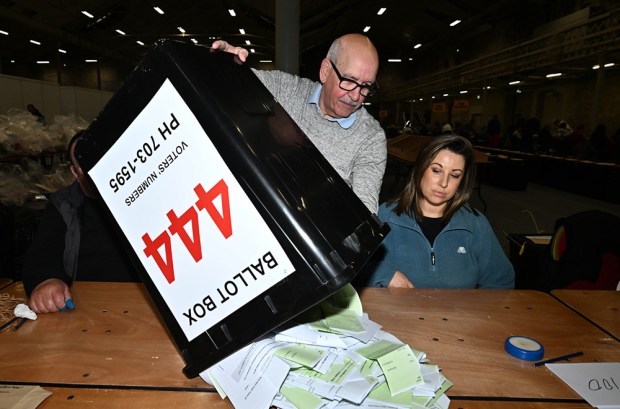Australia’s Constitution copied much from the United States. We explicitly opted for an American-style federalist arrangement whereby only the centre’s heads of powers are listed, and what is not listed goes to the States. This is in contrast to the Canadian model, where the powers of both the centre and the provinces are listed, the goal there being to weaken the provinces.
By contrast, the American system and hence ours was designed to produce strong States. Alas, our High Court, and nine decades of decisions that overwhelmingly favour the centre, have frustrated those clear and obvious intentions. For some recent examples, read the almost grotesquely implausible Tasmanian Dam case, or Work Choices. Or how income taxing power was taken from the States.
Perhaps, though, it is best to pass over in silence the sorry state of federalism in this country, and how the original intentions of the founders of our Constitution have been thwarted; to bad effect in my opinion. Instead, consider the other item we took more or less whole from the Americans: their model of bicameralism.
We opted for an elected Upper House, in line with the American model. That is not the case in Britain, Canada or New Zealand. Indeed to this day Canada has a wholly unelected Upper House Senate which because it is inhabited only by appointed placemen has no legitimacy and blocks next to nothing. The same can be said of Britain’s House of Lords. And New Zealand doesn’t even bother with any sort of Upper House at all.
Now notice that an elected Senate such as ours will inevitably have real power. That, indeed, lies at the heart of the Madisonian design. It is meant to be a check and balance on the Lower House. A Senate that blocks things is not a design flaw; it is what it was designed to do.
Of course the Lower House, the House of Representatives, has more democratic legitimacy. Why? Well for the House everyone in the country counts more or less equally. Put the same number of voters in each district or electorate and then vote. For the Senate, though, voters in small States count for way more than in big States and that’s because each State gets the same number of Senators, namely 12. Put differently, if you are voting for the Senate in Tasmania your vote is worth about 15 times as much as someone’s vote in New South Wales.
That was part of the federalist deal to get the small States on board. The idea was that the Senate would represent and look after the States. Yet the onslaught of powerful political parties has ensured that that is completely out the window.
Now, it’s not that I dislike having a strong Upper House. I sit on the fence on that question. I can see the advantages and disadvantages of Canadian and British pseudo-unicameralism, as I can of US-style Madisonian strong bicameralism.
The problem is that our Senate, which perhaps alone in the Westminster world can even block money Bills, has veered too far from the American model it copied. I’m more or less content to have voters in little States get a considerably disproportionate say, and for Senators to serve double terms, to slow down the pace at which change can occur. I’m even content with a voting system for the Senate that results in the main political party that loses an election nevertheless win in the Senate to serve as a check on what can be done by the winning political party.
What I am not content with is a bicameral system where a few independent oddballs decide what will or will not be passed. Not even James Madison wanted a checks and balances set-up where the person doing the checking and balancing would be Clive Palmer. And notice that in the US it is a two party game. The checking and balancing there is done wholly by the other side of politics. The voters therefore know who to punish or reward.
In Australia, however, with our STV voting system in the Senate we’ve reached a bizarre situation where people who garner a minute share of the vote are deciding if we will get rid of renewable energy targets or deregulate universities. That can hardly be described as overly democratic, or part of the original federalist deal, or even as an integral component of some Madisonian set-up.
Now, I well know that before 1949, when we voted for our Senate using the same majoritarian, non-proportional voting system as in the Lower House, what we got were massive winner-takes-all outcomes. One of the big parties would take almost all the seats for any particular state, so that you’d end up with ludicrously lop-sided results in the Senate.
To be honest, I’d prefer that model to what we have now. If Labor were in government in the Lower House with the Coalition controlling a lopsided majority in the Senate, voters would know who to reward or punish for obstreperous gridlock. With today’s system, they do not.
More importantly, the fine balances in our constitutional system, and most especially the double dissolution election, work far better in my view under the pre-1949 Senate voting system. If a recalcitrant Labor, and only Labor, were blocking today’s Coalition, then Mr Abbott could call a double dissolution election and he would know either he wins, or Labor wins, or there’s a joint sitting awaiting a status quo result.
However, under today’s STV Senate voting system a double dissolution election just means that it is even easier for Palmer’s party and the Greens and the panoply of minute micro-parties to get back in. Sure, you might get a joint sitting and pass one or two Bills. But you’re then stuck with an even worse Senate.
And that makes the double dissolution election, part of the original compromise that would constrain our comparatively über-powerful Senate, very unattractive to use.
Let me put this in blunt terms. We need to change the voting system used in the Senate. I would go back to the pre-1949 arrangements, lopsided results and all. I suspect most others will reject that. Okay, so give us some alternative, any alternative. As things stand now I’m starting to think the basically unicameral Canadian and British set-ups, where Prime Ministers Harper and Cameron get elected and bring in any budget they want, is better than what we’re seeing here.
Got something to add? Join the discussion and comment below.
Get 10 issues for just $10
Subscribe to The Spectator Australia today for the next 10 magazine issues, plus full online access, for just $10.
James Allan is Garrick Professor of Law at the University of Queensland
You might disagree with half of it, but you’ll enjoy reading all of it. Try your first month for free, then just $2 a week for the remainder of your first year.













Comments
Don't miss out
Join the conversation with other Spectator Australia readers. Subscribe to leave a comment.
SUBSCRIBEAlready a subscriber? Log in